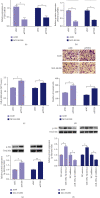MicroRNA-103a-3p Promotes Cell Proliferation and Invasion in Non-Small-Cell Lung Cancer Cells through Akt Pathway by Targeting PTEN
- PMID: 34307670
- PMCID: PMC8279842
- DOI: 10.1155/2021/7590976
MicroRNA-103a-3p Promotes Cell Proliferation and Invasion in Non-Small-Cell Lung Cancer Cells through Akt Pathway by Targeting PTEN
Abstract
Background: Increasing evidence has suggested that microRNA- (miR-) 103a-3p is crucial for cancer progression. However, the specific mechanism of miR-103a-3p in non-small-cell lung cancer (NSCLC) remains unclear until now. So, it is particularly urgent to clarify the mechanism between them.
Methods: qRT-PCR and western blot were used to measure the expression of miR-103a-3p, PTEN, Akt, and p-Akt. Cell biology experiment was applied to detect the biological function of miR-103a-3p in NSCLC cell lines. Moreover, bioinformatics analysis, luciferase reporter assay, and functional complementation analysis were carried out to investigate the target gene.
Results: miR-103a-3p was highly expressed in primary NSCLC samples and cell lines. miR-103a-3p mimics promoted the proliferation and invasion of NSCLC cells; miR-103a-3p inhibitor had the opposite effect. A double luciferase reporter gene experiment revealed that miR-103a-3p directly targets the PTEN mRNA 3'UTR region. siPTEN inhibited the proliferation and invasion of NSCLC cells. Further mechanistic studies showed that both overexpression of miR-103a-3p and PTEN knockdown reduced the expression of the p-Akt protein. Overexpression of PTEN partially reversed the cancer-promoting effect of miR-103a-3p.
Conclusion: miR-103a-3p promotes the progression of NSCLC via Akt signaling by targeting PTEN, highlighting the role of miR-103a-3p/PTEN/Akt signaling and suggesting miR-103a-3p as a novel therapeutic target for NSCLC.
Copyright © 2021 Haixun Li et al.
Conflict of interest statement
The authors declare no conflicts of interest.
Figures




References
MeSH terms
Substances
LinkOut - more resources
Full Text Sources
Medical
Research Materials

